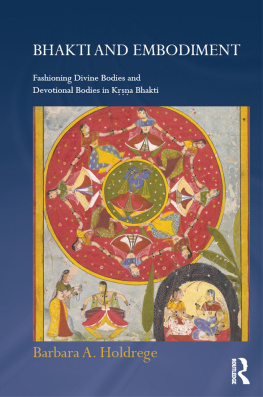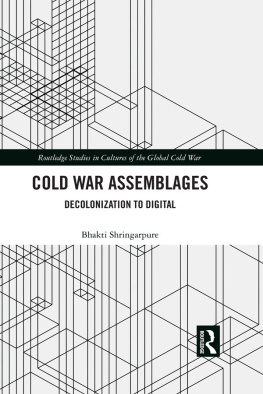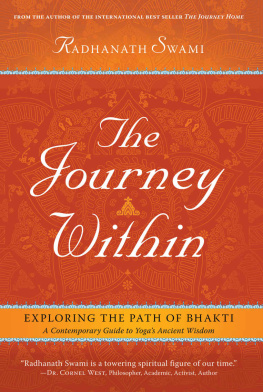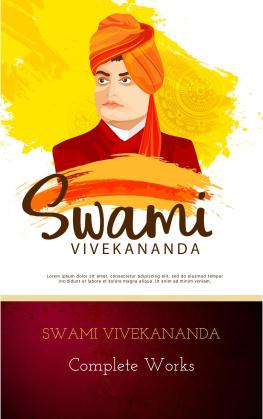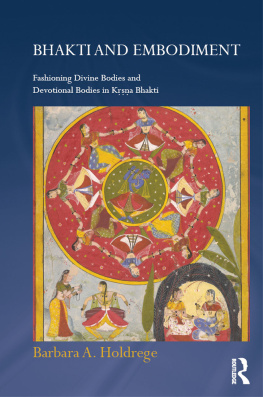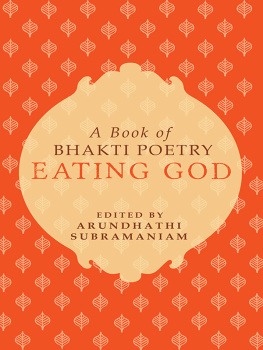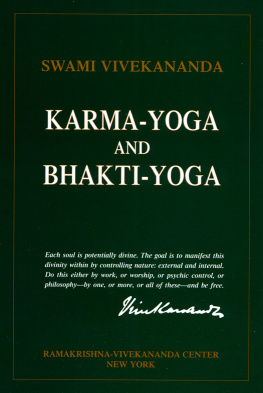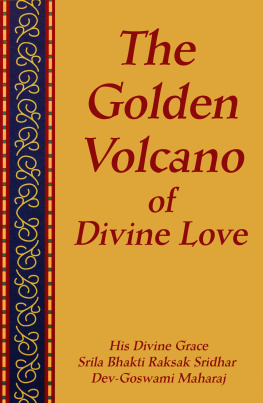Barbara A. Holdrege - Bhakti and Embodiment: Fashioning Divine Bodies and Devotional Bodies in Krsna Bhakti
Here you can read online Barbara A. Holdrege - Bhakti and Embodiment: Fashioning Divine Bodies and Devotional Bodies in Krsna Bhakti full text of the book (entire story) in english for free. Download pdf and epub, get meaning, cover and reviews about this ebook. year: 2015, publisher: Routledge, genre: Religion. Description of the work, (preface) as well as reviews are available. Best literature library LitArk.com created for fans of good reading and offers a wide selection of genres:
Romance novel
Science fiction
Adventure
Detective
Science
History
Home and family
Prose
Art
Politics
Computer
Non-fiction
Religion
Business
Children
Humor
Choose a favorite category and find really read worthwhile books. Enjoy immersion in the world of imagination, feel the emotions of the characters or learn something new for yourself, make an fascinating discovery.
- Book:Bhakti and Embodiment: Fashioning Divine Bodies and Devotional Bodies in Krsna Bhakti
- Author:
- Publisher:Routledge
- Genre:
- Year:2015
- Rating:3 / 5
- Favourites:Add to favourites
- Your mark:
Bhakti and Embodiment: Fashioning Divine Bodies and Devotional Bodies in Krsna Bhakti: summary, description and annotation
We offer to read an annotation, description, summary or preface (depends on what the author of the book "Bhakti and Embodiment: Fashioning Divine Bodies and Devotional Bodies in Krsna Bhakti" wrote himself). If you haven't found the necessary information about the book — write in the comments, we will try to find it.
The historical shift from Vedic traditions to post-Vedic bhakti (devotional) traditions is accompanied by a shift from abstract, translocal notions of divinity to particularized, localized notions of divinity and a corresponding shift from aniconic to iconic traditions and from temporary sacrificial arenas to established temple sites. In Bhakti and Embodiment Barbara Holdrege argues that the various transformations that characterize this historical shift are a direct consequence of newly emerging discourses of the body in bhakti traditions in which constructions of divine embodiment proliferate, celebrating the notion that a deity, while remaining translocal, can appear in manifold corporeal forms in different times and different localities on different planes of existence. Holdrege suggests that an exploration of the connections between bhakti and embodiment is critical not only to illuminating the distinctive transformations that characterize the emergence of bhakti traditions but also to understanding the myriad forms that bhakti has historically assumed up to the present time.
This study is concerned more specifically with the multileveled models of embodiment and systems of bodily practices through which divine bodies and devotional bodies are fashioned in Krsna bhakti traditions and focuses in particular on two case studies: the Bhagavata Purana, the consummate textual monument to Vaisnava bhakti, which expresses a distinctive form of passionate and ecstatic bhakti that is distinguished by its embodied nature; and the Gaudiya Vaisnava tradition, an important bhakti tradition inspired by the Bengali leader Caitanya in the sixteenth century, which articulates a robust discourse of embodiment pertaining to the divine bodies of Krsna and the devotional bodies of Krsna bhaktas that is grounded in the canonical authority of the Bhagavata Purana.
Barbara A. Holdrege: author's other books
Who wrote Bhakti and Embodiment: Fashioning Divine Bodies and Devotional Bodies in Krsna Bhakti? Find out the surname, the name of the author of the book and a list of all author's works by series.

